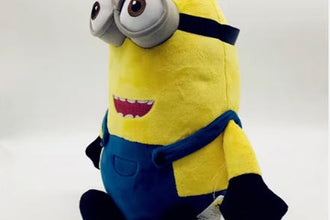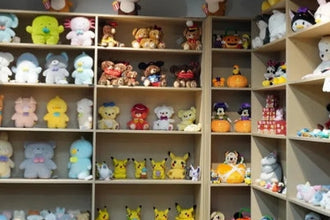Size of a plush toys is a major factor in its appeal, functionality and marketability. If you're creating plush toys for children, promotional items or for collectors, customizing the size allows you to meet specific requirements and create a unique product that is distinctive. Understanding the considerations behind the custom plush size will help manufacturers, designers and businesses make informed decisions that enhance the toy's usability, safety, and aesthetic appeal.

Understanding the Importance of Size in Plush Toys
Size of the plush toys impacts its useability and the overall experience of users. smaller plush toys, like small-sized custom plush keychains are easy to carry around and can be used as gifts, collectibles or as promotional gifts. The larger plush toys however provide a soothing and a huggable experience for kids or can be used as a statement piece to decorate your home. If you choose the right dimensions, manufacturers can be sure that the item is suitable for the needs of the intended audience regardless of whether it's to be used for display, play, or even gifting.

Common Size Ranges and Their Ideal Uses in Custom Plush Toys
This chart assists manufacturers, designers and consumers quickly identify the optimal size range for custom plush toys according to their intended use and target audience.
|
Size Range |
Description |
Ideal Uses |
|
Miniature (3-6 inches / 7-15 cm) |
Small, compact, usually keychains or pocket-sized |
Collectibles Promotional products, gifts for small occasions favors for parties |
|
Small (6-12 inches / 15-30cm) |
Simple to carry and hold Ideal for small children. |
Toys for children, travel-friendly toys and desk or shelf decorations |
|
Medium (12-18 inches / 30-45 cm) |
Large size, flexible to play with and display |
Bedtime companions, playroom toys, gifts, moderate display items |
|
Large (18-24 inches or 45-60 cm) |
Larger, more tactile visually appealing |
Statement pieces, comfort toys displays and adult collectibles |
|
Extra Large (24-36 inches / 60-90 cm) |
Super-large plush, extremely huggable and attractive |
Promotional displays, specialties and oversized collectibles for decorating your home |
|
Giant (36 inches+ /90 cm or more) |
Large, often used as a focal point |
Decorate the room, promote events, large gift cards, photo opportunities |

Key Factors to Consider for Choosing the Right Size for Custom Plush Toys
1. Target Audience and Age Group
The intended audience for the toy with a plush face is among the most important factors. For children and toddlers toys that are plush must be light, simple to hold, and appropriate for tiny hands. Larger toys can be a burden or difficult to hold for young children, while smaller toys could be dangers of choking. For teenagers, older children or collectors of adults bigger sizes may enhance the appeal of a toy and offer a more enjoyable sensory experience. Knowing the intended audience will ensure that the size meets safety and usability.
2. Purpose and Functionality of the Plush Toy
The intention behind the toy determines the appropriate size. Toys designed for comfort like bedtime companions have a more and more huggable size, which provides an incredibly soft and relaxing experience. Littler plush toys, like keys or miniature collectibles are ideal for transportability and gifting reasons. The way the toys is going to be used aids in the selection of a size to maximize its value.

3. Design and Aesthetic Considerations
Dimensions affect the visual appearance and proportions of a soft toy. Designers should consider how the different dimensions impact the look of the toy by ensuring elements like eyes, ears, as well as legs are in balance. Toys that are too big or tiny in comparison with its components may appear unbalanced or dull. A careful consideration of proportions will ensure that the toy is visually appealing in its size.

Large Size Teddy Bear
4. Material and Manufacturing Constraints
Dimensions of toy directly influences the materials needed and the complexity of production. Larger toys require a greater amount of material, stuffing, and reinforcements to keep the shape and quality, which can result in higher production costs. Smaller toys could require exact stitching and fine details that can impact the cost of labor. Working with manufacturers to identify possible sizes allows you to ensure that design goals are balanced with manufacturing and material constraints.
5. Safety and Regulatory Compliance
Safety is an essential aspect when it comes to determining the size of a plush toys especially for toys designed for children. Toys need to be compliant with regulations that restrict small pieces or parts that may cause choking dangers. The large size of plush toys although generally safe in a small-parts perspective they must be controlled in size and weight to avoid injuries during play or handling. Making sure that the toys are safe is crucial when deciding on the size.
6. Budget and Cost Considerations
Size is a major factor on the cost of manufacturing plush toys. The larger sizes require more material and labor costs and can result in more shipping costs. Smaller sizes use less materials however, they may require complex craftsmanship which can increase production costs. Considering the budget in conjunction with the desired size aids in making a plush toy that is appealing and economically feasible.
7. Market Trends and Consumer Preferences
The trends in the market and expectations of consumers will also affect the size selection. The plush toys with the largest sizes are well-known for their unique and comfort. Meanwhile, tiny plush toys have gained recognition as collectibles or promotional products. Knowing the current trends in the market can aid designers in choosing sizes which are likely to attract customers and satisfy consumer demand.

Future Trends in Size Customization for Plush Toys
As the demands of consumers diversify and technology for manufacturing advances as well, the ways that custom plush toys are designed, produced, and marketed will more be increasingly focused on offering a range of sizes to meet diverse needs, experiences and markets.
1. Personalized and On-Demand Sizes
One of the most important developments in the coming years of plush toys is personalization and on-demand size. Innovations in custom plush manufacturing technology, like digital patterning and automated cutting enable manufacturers and designers to provide plush toys with custom sizes that are tailored to the individual's preferences. Customers could soon be able to choose the exact size of their favorite characters, resulting in a deeper and personal relationship with the item. This is especially appealing to those looking for gifts, special occasions and collectors who want exclusive products.
2. Expansion of Miniature Collectibles and Series
The market in miniature custom plush toys is predicted to rise even more thanks to the increasing popularity of series that collectibles are as well as subscription box. Miniature toys, generally between 3 and six inches in size, is ideal for those who collect and want to build full sets, or theme exhibits. Future trends could include more complex designs in miniature using high-precision stitching and details to ensure quality despite the small dimensions. These toys are also low-cost options for promotional campaigns and giveaways.

3. Oversized and Huggable Plush Toys
These oversized plush toys currently ranging from 24 inches to 36 inches in length, have become becoming thought of as fashion pieces and as a comfort item. In the future, plush toys are likely to become bigger and more engaging and incorporate features like the use of weighted stuffing to provide sensory comfort, or integrated technology to provide additional capabilities. Consumers are looking for more immersive experiences. large plush toys are an effective way to foster emotional connection, especially for those who appreciate huggable, large friends.

4. Multiple Size Variants for Single Designs
The future trends suggest an increasing demand for various sizes of the same design. This allows brands to meet various needs of their customers without creating completely new designs for every market segment. For example, one design could be sold as a small keychain the size of a medium-sized plush and even a huge display piece. The availability of a variety of sizes allows the market's flexibility and allows customers to select the right product for their budget, space, and purpose of use.
5. Sustainable Size Customization
Environmental concerns are likely to affect future trends in size for plush toys. Manufacturers can optimize sizes to minimize waste materials especially in larger plush toys by balancing the dimensions with efficient filling and use of fabrics. The smaller sizes can be made using recycled or sustainable materials that appeal to environmentally conscious buyers. Sustainable size modification will be a major selling point in the future since consumers are increasingly looking for environmentally friendly choices when they shop.
6. Integration of Technology with Size Variations
Innovations in the field of smart toys could also influence future trends in the field of size and customization. Toys with different sizes may include interactive elements like lighting, sound or haptic feedback customized to the dimensions that the toys are. For example, smaller toys might have simple audio capabilities, while larger ones can provide interactive experiences. The combination of the ability to customize size and technology will open up new possibilities for interaction playing, enjoyment, and emotional connections.

7. Working with manufacturers to develop Custom Plush Sizes
Collaboration with manufacturers is crucial in the creation of custom plush toys that have specific dimensions. Professionally trained custom plush manufacturers can provide advice regarding the most feasible dimensions, materials selection, and manufacturing techniques to ensure that the product is sturdy and of high-end quality. They will advise you on the the cost implications of different sizes, suggest changes to ensure safety and ease of use and assist in optimizing designs to ensure efficient production. Through close collaboration with designers, manufacturers and brands can find the perfect balance of the size, functionality aesthetics, budget, and size creating plush toys that satisfy the needs of consumers and the demands of the market.
Implementer is a reputable manufacturer of custom plush toys, specializing in making high-end, custom plush toys. With years of knowledge of production, design and selecting materials, Implementer helps brands and designers bring their unique plush toys concepts to reality. They provide expertise in special sizes, innovative features, and secure sturdy construction that ensures each and every plush item meets functional and aesthetic standards.

Summary
Custom plush size is a critical element that determines the usefulness, the appeal and cost-effectiveness of plush toys. When considering the intended audience, the purpose, safety, material costs and market trends, designers and businesses can decide on most appropriate dimensions to maximize satisfaction and value. If you are creating a mini collectible or a huge huggable toys, careful customization of plush size makes sure that the toy provides the desired experience and stands out in the competitive custom plush market.







